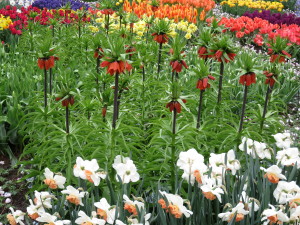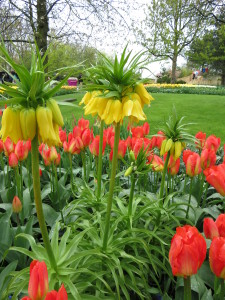Crown imperial (Fritillaria imperialis), aka fritillaria, is an impressive spring flowering bulb that is native of Southwestern Asia to the Himalayas (USDA hardiness zones 5-8). In late April to May, large drooping orange, red, or yellow bell-shaped flowers are topped by a small pineapple-like tufts of leaf-like bracts. The leafy fringe on top resembles a crown, hence the common name “Crown Imperial”. All parts of the plant emit a skunk-like odor.
Individual bulbs grow 3-5 feet tall and 1 to 1½ feet wide. Some gardeners will inter-plant multi-rows of mid- to late-season tulips, daffodils, et al. with the taller growing fritillarias. Each bulb produces flowers on top of a thick, stout, upright flowering stem. Lance-shaped green leaves (to 6 inches long) have wavy margins and appear in whorls around the lower one-half of stem.
Fritillarias are at their best in full sun. Plant bulbs 6-8 inches deep in compost-rich, moist, very well-drained, high pH soils. Space bulbs 12 or more inches apart in autumn for adequate winter chilling in the winter soil. Protect from high wind or be prepared to stake stems.
According to Brent Heath, from Brent and Becky’s Bulbs in Gloucester, VA, “if you garden in most areas of the Eastern or Midwestern U.S., fritillarias are very challenging to grow. Gardeners in the Southwestern U.S. have the best luck with growing fritillaries”. They suffer in heavy clay soils which tend to stay very wet during summer and winter months, resulting in bulbs to rot in the ground.
Foliage dies back by early summer as the bulbs go dormant. Bulbs are large but fragile and are best left undisturbed once planted. Bulbs are best mulched with medium to coarse bark mulch to provide winter protection. Fritillarias resent highly moist soils, particularly in the summer and winter months which leads to bulb rot. Plants are also susceptible to leaf spot, rust and mosaic virus. Most critters like voles, squirrels and deer leave fritillarias alone.
Tip: Excellent soil drainage is the key. Plant on a bed of gravel or coarse sand. Set each bulb on its side to keep water from collecting in the depression at the top of the bulb to prevent or reduce bulb rotting.
To create a spectacular display, plant 6-12 bulbs in the rear of a spring flower border where they can be clearly viewed but their unpleasant flower and foliage fragrance will not picked up.



 Posted in
Posted in 
